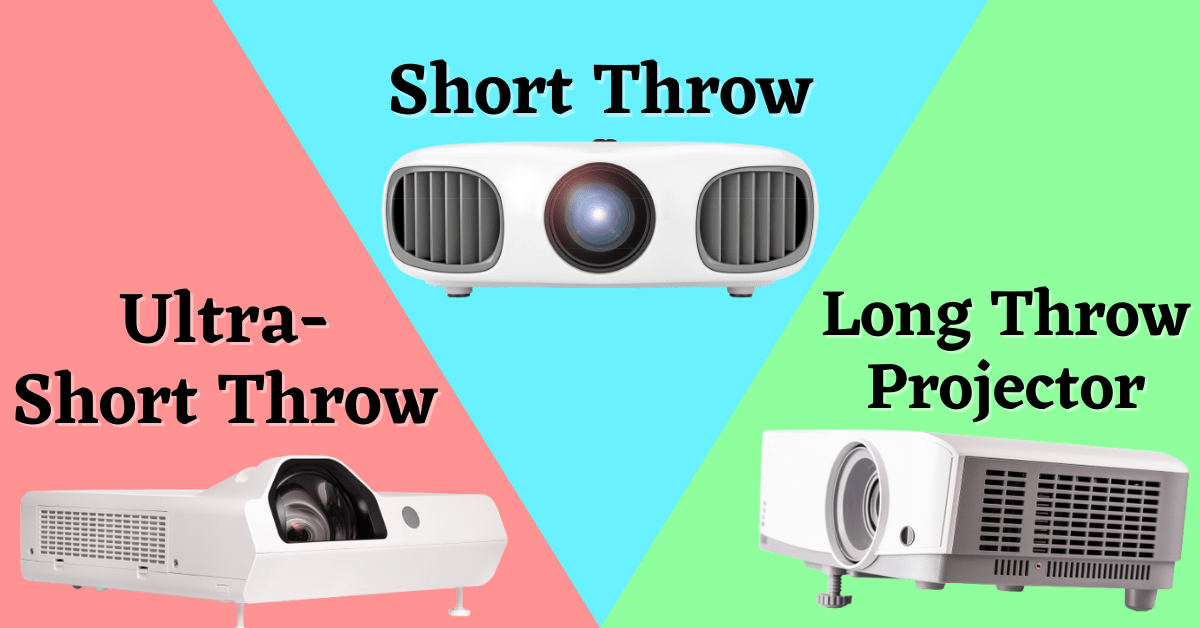Last Updated on September 10, 2024 by Admin
Projectors are generally categorized into three types based on their throw distance: Ultra Short Throw, Short Throw, and Long Throw. Selecting the right type depends on your specific needs. In this article, we will compare Ultra Short Throw Vs Short Throw Vs Long Throw projectors to highlight the advantages of each.
When selecting a projector, understanding projector throw distances is crucial for achieving the best viewing experience in your space. The throw distance is the distance between the projector and the screen, and it plays a significant role in determining the projector’s suitability for your room. Ultra Short-Throw, Short-Throw, and Long Throw projectors each have unique characteristics that cater to different room sizes and setups:
Ultra Short-Throw Projectors can project large images from a very short distance, making them ideal for small rooms or spaces where placement is close to the screen.
Short-Throw Projectors offer a moderate throw distance and are useful in medium-sized rooms where space constraints prevent placing the projector far from the screen.
Long Throw Projectors require more distance to project large images, making them suitable for larger rooms or auditoriums where the projector can be placed further away from the screen.
Understanding these differences helps ensure you choose a projector that fits your room’s dimensions and your viewing needs.
Page Contents
What is a Projector Throw Distance?
Throw distance refers to the distance between the projector lens and the projection screen or surface. It determines how far back you can place the projector while still achieving a clear, properly sized image.
The throw ratio is a key metric used to calculate throw distance. It is the ratio of the distance from the projector to the screen (throw distance) divided by the width of the projected image. For example, if a projector has a throw ratio of 1.5:1, it means that for every 1 foot of image width, the projector needs to be 1.5 feet away from the screen.
Knowing the throw ratio helps you plan your room setup effectively, ensuring that the projector fits within the space constraints while delivering an image of the desired size. For instance:
Ultra Short-Throw Projectors have a throw ratio of less than 0.4:1, allowing placement just inches from the screen.
Short-Throw Projectors typically have a throw ratio between 0.4:1 and 1.0:1, suitable for relatively close placements.
Long Throw Projectors generally have a throw ratio greater than 1.0:1, requiring more distance between the projector and the screen.
Understanding these factors ensures you select a projector that not only fits your space but also meets your viewing and imaging requirements.
So, you can choose the Type of Projector that is suitable for you.
Long Throw/ Standard Projectors:
We typically refer to them as Standard Projectors, the type most commonly used over the years. Standard Projectors are positioned at a distance from the screen and project light onto it. Although they were once simply known as Normal Projectors, they are now often called Long Throw Projectors to differentiate them from newer types that have emerged.
Short Throw Projectors:
Short Throw Projectors were introduced afterward, featuring improved lenses that allow them to be placed closer to the screen without compromising image quality. These projectors quickly gained popularity among home users, as they are more suitable for smaller rooms, making them a preferred choice over Long Throw Projectors.
Ultra Short Throw Projectors:
Ultra Short Throw (UST) Projectors have been introduced more recently and have quickly become popular among many users. These projectors feature a lens positioned on top of the device, allowing them to be placed extremely close to the screen while still delivering a large, high-quality image. Read more on What is Ultra Short Throw Projector.
Ultra Short Throw Vs Short Throw Vs Long Throw Projector:
Let’s differentiate between Ultra Short Throw Vs Short Throw Vs Long Throw Projector to see Which Type of Projector has more benefits over others.
1. Installation:
Installing a standard projector can be quite difficult, often requiring technical expertise to set it up properly. If you plan to mount the projector on the ceiling, professional help may be necessary. This involves drilling holes in the ceiling and ensuring the projector is positioned at the correct distance for optimal performance.
Check out How Far the Projector Needs to be from the Screen.
Installing a Short Throw Projector can be just as challenging as setting up a Long Throw Projector.
In contrast, Ultra Short Throw Projectors are much simpler to install. They can be easily placed right in front of the screen, requiring no professional assistance. You simply position the UST projector 7 to 12 inches away from the screen, depending on the screen size.
Winner: Ultra Short Throw Projector
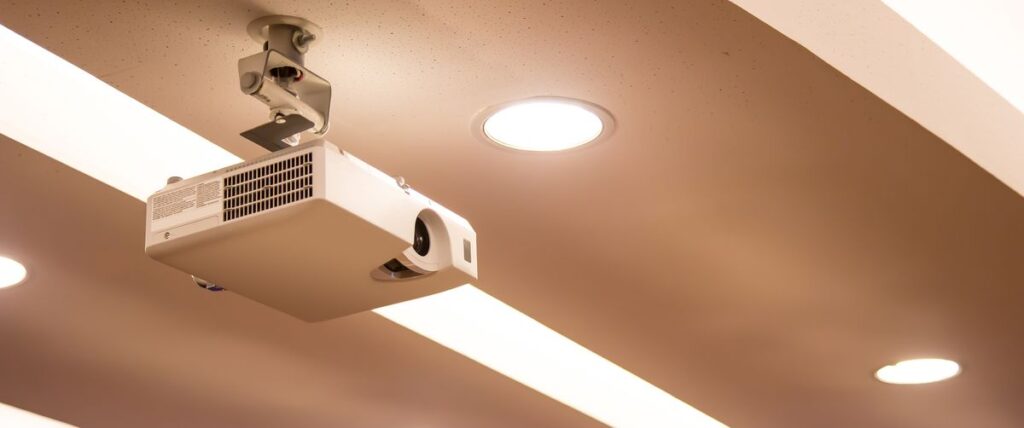
2. Portability:
As noted earlier, Short Throw Projectors are relatively easy to install and can be moved to different walls or rooms with minimal hassle.
In contrast, relocating a Standard Long Throw Projector can be quite cumbersome. It requires a significant distance from the screen, necessitates a large room, and often demands rearranging the furniture. If you prefer not to disrupt the room setup, you might even need to install the projector on another ceiling, which involves additional modifications.
Short Throw Projectors are somewhat easier to move than Long Throw models, but you may still need to adjust the furniture to achieve the optimal projection distance.
If you want a Portable Projector, you can look for a Pico Projector.
Winner: Ultra Short Throw Projector
3. Space:
Long Throw Projectors must be positioned at least 6 feet away from the wall or screen. Additionally, there should be no obstructions between the projector and the screen. To project a larger image, the distance needs to be increased, requiring an unobstructed area in front of the projector. This setup also necessitates that you sit behind the projector. If you choose to project from behind the screen, even more space will be required.
Check out the difference between Front Projection Vs Rear Projection.
Short Throw Projectors can be positioned much closer to the screen, saving nearly half the space compared to Long Throw Projectors.
They can be placed just a few inches away from the wall, making them suitable for even small rooms.
Winner: Ultra Short Throw Projector
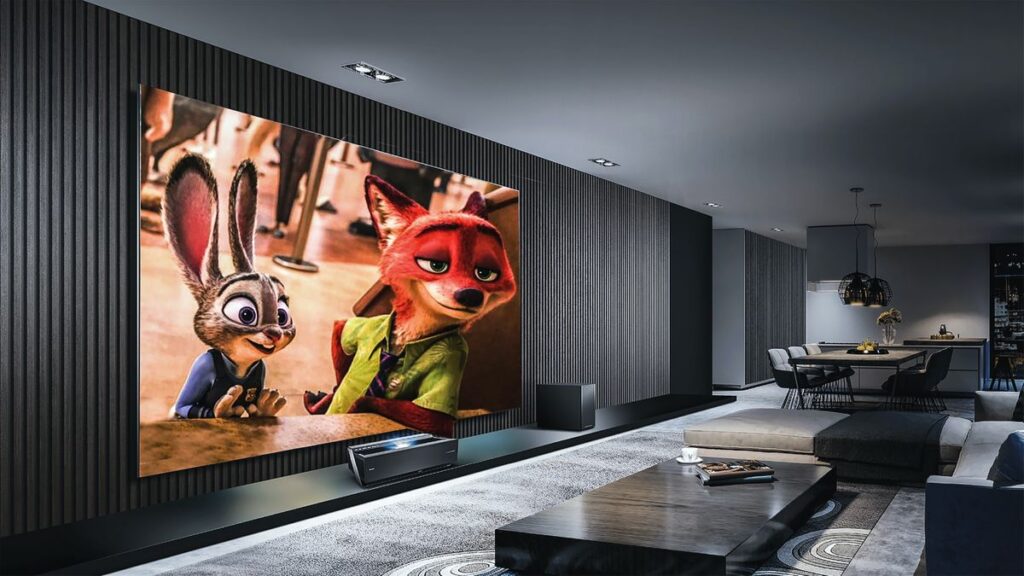
4. Cables & Wires:
If you mount a Long Throw Projector on the ceiling, you’ll need a long HDMI cable to connect it to your device, which can be quite expensive. Even if placed in the center of the room, the projector needs to be plugged into a power socket, and if the socket is far away, an extension cord will be necessary.
Additionally, speakers are often positioned near the projector screen, requiring a long AUX cable to connect them to the projector. Managing all these wires and cables can lead to a tangled mess.
In contrast, Short Throw Projectors can be positioned closer to the screen, reducing the need for long cables. This allows for a cleaner, more straightforward setup without the hassle of extensive wiring.
Winner: Ultra Short Throw Projector
5. Interference:
Placing a projector close to the screen helps minimize interference from objects and people. This advantage makes Ultra Short Throw Projectors superior to both Short Throw and Long Throw Projectors, as they significantly reduce the risk of shadows and obstructions.
Winner: Ultra Short Throw Projector
6. Rear Projection:
Ultra Short Throw Projectors are ideal for both front and rear projection, as they require minimal space. In contrast, placing a Short Throw or Long Throw Projector behind the screen consumes significant space. A Long Throw Projector, for example, needs to be positioned about 8 feet behind the screen, with viewers seated at least 10 feet away. This setup demands considerable room, making it less efficient compared to Ultra Short Throw Projectors.
Also, if you are placing a Projector behind the Screen, you should get an Acoustic/Perforated Screen. Read more about Types of Projector Screens here.
Winner: Ultra Short Throw Projector
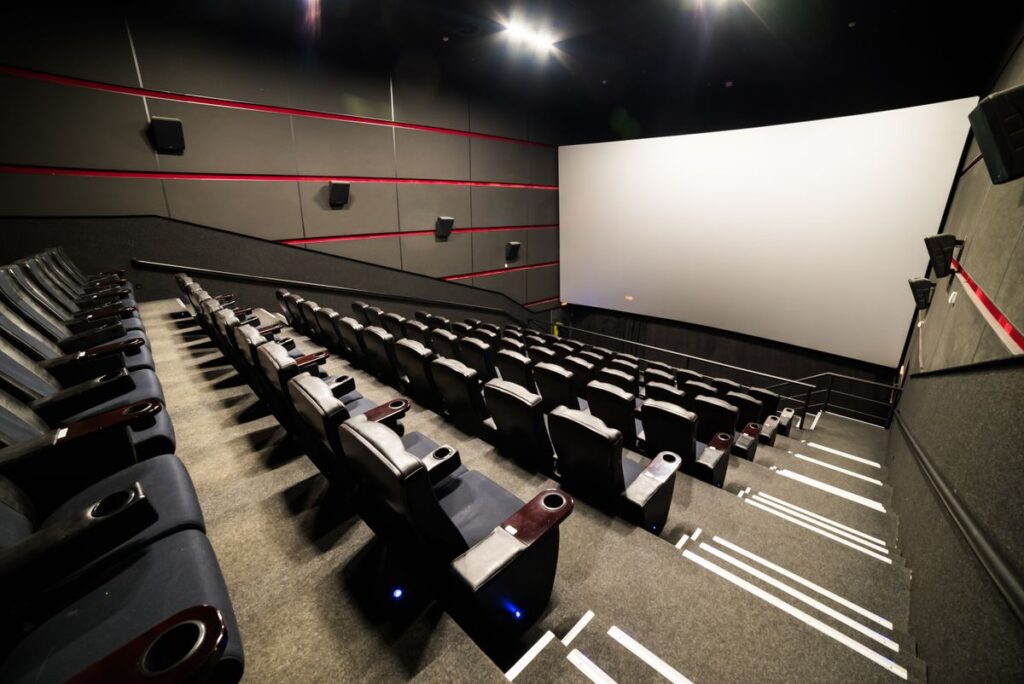
7. Sound:
Some projectors come with built-in speakers, but their sound quality is often less than ideal, whether it’s a Short Throw or Long Throw model. Consequently, a separate sound system is usually necessary. Long Throw Projectors, being closer to you, generally provide more audible sound compared to Ultra Short Throw Projectors, which are placed near the wall.
However, when used as a rear projector, the Ultra Short Throw Projector can produce better sound than a Long Throw Projector, which is positioned about 7-8 feet away from the screen.
Ultimately, whether a Short Throw or Long Throw Projector is better depends on your seating distance and usage preferences. Therefore, there is no clear winner; it varies based on individual requirements and setup conditions.
8. Ambient Light Rejection:
In the comparison of Ultra Short Throw, Short Throw, and Long Throw Projectors, handling ambient light is a crucial factor.
When using a projector in daylight or in a well-lit room, Long Throw Projectors, which project from a greater distance, are more susceptible to interference from ambient light. This can result in a duller picture quality.
Also, read What is Throw Ratio in a Protector.
On the other hand, Short Throw Projectors, positioned closer to the screen, experience less light interference, providing better image quality, contrast, and brightness.
Ultra Short Throw Projectors, being placed just inches from the screen, are least affected by ambient light, making them the most effective at maintaining image clarity and brightness in such conditions.
If you prefer a Long Throw Projector, consider one with high lumens for better performance in bright environments.
Check out What is Lumens in Projector.
Additionally, using an Ambient Light Rejecting (ALR Screen) screen can further enhance image quality by minimizing light interference.
Winner: Ultra Short Throw Projector
9. Safe Environment:
If a projector is placed in the middle of the room, it’s more likely that people might bump into it, and the area can become congested with wires and cables, creating obstacles.
In contrast, Ultra Short Throw Projectors have a clear advantage here as they are positioned very close to the screen, reducing the risk of interference and keeping the area less cluttered.
While Long Throw Projectors can be mounted behind the screen or on the wall, this introduces additional challenges related to space and installation. Therefore, Ultra Short Throw Projectors generally offer a safer and more convenient setup.
Winner: Ultra Short Throw Projector
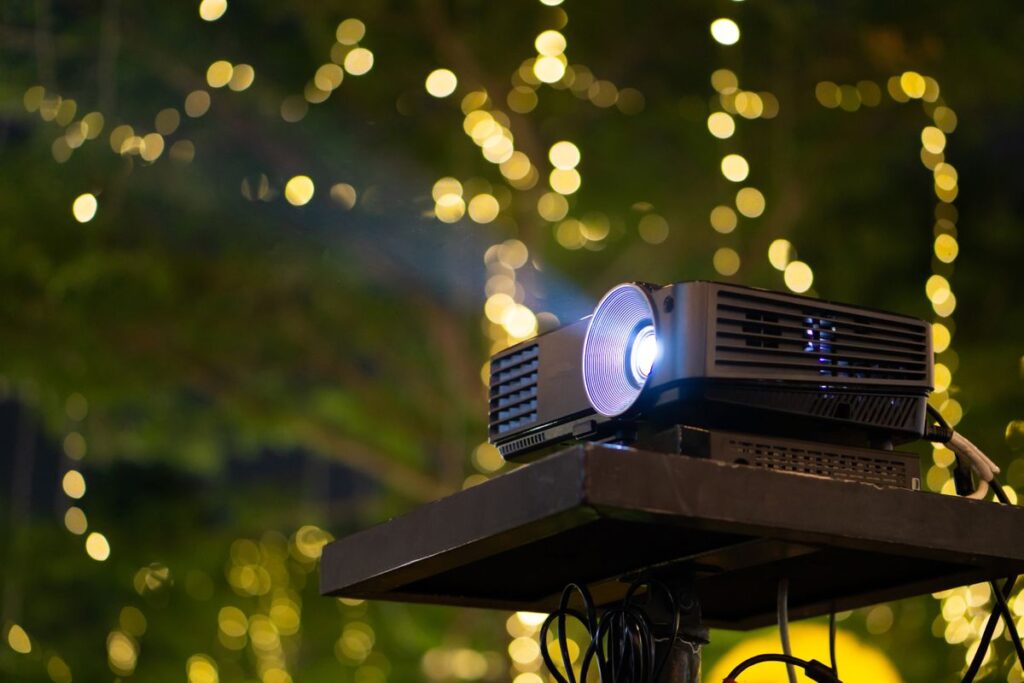
10. Light Source:
In our previous article on Types of Projectors, we discussed that Standard Projectors utilize three types of light sources: DLP, LCD, and Laser. Most Short Throw and Ultra Short Throw Projectors feature a Laser light source, which offers superior color accuracy, better contrast, deeper blacks, and a longer lifespan.
Given these advantages, the choice between these types of projectors comes to a draw when considering light source quality.
11. Screen Size:
Since Ultra Short Throw Projectors are positioned very close to the screen, they typically cannot project extremely large images. Short Throw Projectors can project up to 120 inches, or even 150 inches at most. For larger screens, such as those exceeding 200 inches, a Long Throw Projector is more suitable. This is why Long Throw Projectors are commonly used in movie theaters, where large screen sizes are essential.
Winner: Long Throw Projector
12. Screen Types:
An Ultra Short Throw Projector is ideal for use with Portable Screen Types. You can easily place the screen wherever you like and position the UST projector in front of it. They also work well with Fixed Projector Screens. However, UST projectors are generally not suitable for Retractable Screens, as these screens are often placed in the middle of the room, which may obstruct the projector’s placement.
In contrast, Standard Projectors are compatible with all types of screens, including Portable ones. The main requirement is ensuring there is enough space for proper projection.
Winner: Long Throw Projector
13. TV or Movie Theatre:
While Short Throw Projectors offer a TV-like experience with their compact setup and ease of use, Long Throw Projectors deliver a more immersive movie theater feel with larger screen sizes and high-quality visuals.
Which one would you prefer? Share your thoughts in the comments below!
Winner: Long Throw Projector

14. Cost/ Affordability:
After considering all the points, you might think that Ultra Short Throw Projectors are superior to Long Throw Projectors.
However, there’s a crucial factor to consider: affordability. While Ultra Short Throw Projectors offer many advantages, they come with a high price tag—often double or triple the cost of a Standard DLP Projector.
If the Ultra Short Throw Projector suits your environment and budget, it can be worth the investment due to its advanced features. However, as this technology is relatively new and limited in availability, prices may decrease as more manufacturers enter the market.
Despite the benefits of Ultra Short Throw Projectors, many people still opt for Long Throw Projectors primarily due to their lower cost. For those seeking budget-friendly options, Long Throw Projectors are abundant and affordable. Short Throw Projectors, while more affordable than UST models, still cost more than Long Throw Projectors.
Winner: Long Throw Projector
15. Custom Furniture:
In our comparison of different projectors, we’ve highlighted the strengths and weaknesses of each type. However, there’s a common drawback: the need for custom furniture to properly position the projector. The table or stand used should be at the correct height for optimal projection.
If you install the screen before testing the projector, setting up can become challenging. It’s advisable to first test the projector by projecting onto a wall, and then set up the screen. Additionally, you may need to create or order custom furniture to match the required height.
For Ultra Short Throw Projectors, you might need to adjust their distance from the wall to achieve a larger image. Also, if you’re using a home theater system, positioning the projector on top of the center speaker might be necessary.
Also, check out our comparison between Projector Vs TV.
Ultra Short Throw Vs Short Throw Vs Long Throw Projector in Tabular Form:
Here’s a comparison table highlighting the key differences between Ultra Short Throw, Short Throw, and Long Throw Projectors:
| Aspect | Ultra Short Throw Projector | Short Throw Projector | Long Throw Projector |
|---|---|---|---|
| Installation | Easy to Install, No Technical Support Required | Long Installation Process, and might require professional help | Long Installation Process, and might require professional help |
| Portability | Easily Portable | Portable in a few scenarios | Portable in a few scenarios |
| Room Size | Can be used in Small Rooms | Can be used in Medium Size Rooms | Need large space |
| Cabling | Do not require long cables and wires | Medium-length wires can be used | Might require a long HDMI cable and power extension cable. |
| Rear Projection | Suitable for Rear Projection as well | Suitable for Rear Projection but not recommended | Not recommended for Rear Projection |
| Speakers | Require speakers | Speakers are recommended | Placed near to the user, so speakers are not mandatory |
| Ambient Light | Can be used in rooms with Ambient Light | Can be used in Rooms with little Ambient Light | Preferred in dark rooms |
| Physical Safety | People won’t bump into the Projector | Chances of people bumping into the Projectors | Chances of people bumping into the Projectors |
| Light Source | Mostly available with Laser Light Source | Available with DLP, LCD, and Laser lights. | Available with DLP, LCD, and Laser lights. |
| Cost | Very Expensive | Moderate | Budget-Friendly |
| Screen Size | Suitable for Screen Size under 150 inches | Suitable for all screen types and supports large screens as well. | Suitable for all screen types and supports large screens as well. |
| Screen Types | Well suited for Portable and Fixed Screen Types. | Mostly used for Fixed Screen and Retractable Screens. But suitable for all Screen Types. | Mostly used for Fixed Screen and Retractable Screens. But suitable for all Screen Types. |
| Viewing Experience | Gives a TV experience | Gives Movie Theatre feel | Gives Movie Theatre feel |
Conclusion on Short Throw Projector Vs Long Throw Projector:
In conclusion, Ultra Short Throw Projectors offer several advantages over Short Throw and Long Throw Projectors, particularly in terms of installation ease and space-saving. However, their higher cost is a significant factor to consider. Your choice should ultimately depend on your specific needs, preferences, and budget.
If you have a large room with minimal ambient light, a Long Throw Projector might be the most cost-effective and suitable option for you. Conversely, if a Short Throw Projector meets your requirements and fits your space, it could offer good value for the money. If budget is not an issue and you desire the latest technology with minimal setup hassles, then the Ultra Short Throw Projector is worth considering.
We’ve highlighted some of the best Ultra Short Throw Projectors by Optoma for those interested in exploring this option further.
Remember, it’s a one-time investment, so choose the projector that best fits your needs. We’d love to hear your thoughts—let us know which type of projector you prefer: Ultra Short Throw, Short Throw, or Long Throw.

